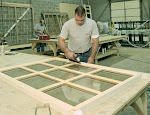I have never been the type of person to enthusiastically join organizations. Whether it was a fraternity in college, business association, church, or country club, I always saw my membership as limiting my involvement in other groups. As is often the case, these groups tend to influence their members to adhere to their guiding principles and to compete with, rather than accept similar organizations that share compatible philosophies. This jaded viewpoint of mine has fueled a healthy skepticism that enables me to see through the groupthink dogma that is associated with even very highly revered institutions. One such organization that has received glowing praise over the past 12 years is the Leadership in Energy and Environmental Design (LEED) that was established by the USGBC.
I think it is time for the construction industry to wake up and begin to think for ourselves again. Too many design and building professionals have drunk the LEED Kool-Aid and have lost their independence. What was originally drafted as an excellent format to realign our priorities towards energy efficiency and environmental stewardship has morphed into a strict guideline that is limiting creativity and compromising common sense in construction. Developers, architects, and contractors who have been challenged by the economic climate have embraced LEED as a means of differentiation. Others have jumped onto the bandwagon just so they wouldn’t be left behind. Now we have a massive fraternity of lemmings, blindly applying their points and paying their dues so they can add four letters to their business card and promote their projects in the marketplace.
It is difficult to be critical of a program like LEED and an organization like the USGBC. This program has had a profound effect on realigning priorities in the construction industry at a time when the United States needed to take serious action in changing the energy consumption and resource utilization of the built environment. By focusing the design community on five main categories of sustainable sites, water efficiency, energy and atmosphere, materials and resources and indoor environmental quality, LEED has had a positive effect on influencing the industry to pay attention to a positive set of guidelines. But over the past couple of years, the LEED program has lost its effectiveness. The industry is tuned into the concept of stewardship and doesn’t need a Martha Stewart recipe for responsible design. And the USGBC leadership has morphed into a capitalistic juggernaut.
Architects, general contractors, manufacturers, forests, distributors, and owners have spent millions of dollars a year to secure and maintain certification in this club. The minimum cost for membership is now $1,500 for a small firm and the cost for manufacturers is staggering. USGBC annual revenues have ballooned to over $107 million dollars and the organization has registered a profit of just under $15 million. Not bad for a non-profit organization. They also have an astounding 36% of revenues allocated to administrative expenses and membership development costs. I tip my hat to the founders for being able to generate such a money making machine in the construction industry during the worst economic times since the great depression. Unfortunately, the immense wealth being amassed by the USGBC is tainting its mission in the same way money has undermined the character of professional sports. For example, the USGBC shelved a much needed revision to the LEED code last year either because of inertia or because of paybacks from contributing groups like the Forest Stewardship Council (FSC).
And the membership costs levied by the venerable USGBC are just part of the equation. In the pursuit of gaining a Platinum status, the entire construction team is burdened by a massive documentation process that audits the intent of the project. The red tape involved in a LEED project makes our government look streamlined. Thousands of hours are spent on a typical project just to track and collect paperwork to justify behavior and intent. Many material costs are also increased because of the perceived value of the LEED certification. For example, we have seen FSC certified wood run 20% higher than the same wood from the same forest without the official certification paperwork. Do we really need to be adding nonsensical administrative costs to the construction process at this moment?
A single program is not capable of satisfying all our challenges in commercial construction. As the USGBC behemoth has grown over the past ten years, its followers have accepted the guidelines without consideration of whether there was a better way. Only recently have we seen opposition to some of the LEED claims and requirements. Henry Gifford has made a compelling argument that the energy saving claims made by USGBC are more a result of manipulating numbers than creating structures that are more energy efficient than the existing stock of buildings. The States of Maine and Georgia have made progress in striking down USGBC requirements of using strictly FSC certified lumber since this eliminates a high percentage of sustainable lumber found in the United States. And in the past year, the Department of Defense abandoned the LEED program for a code based upon ASHRE 189.1. Preservationists are also making compelling arguments to pay attention to the embodied energy of a building rather than replace all elements in the pursuit of superior R Value.
So I ask the design community to regain your independence. Don’t be beholden to a program that is tantamount to a 12-step program for responsible construction. The basis of your design should be predicated upon your inspiration and guided by the owner’s desires, intended use, budget, and presence in the community. Use your common sense rather than a checklist that gives you extra points for bike racks and preferred parking spots for battery powered cars. As was once said by Frank Lloyd Wright, “There is nothing more uncommon than common sense.”






As an architect, I couldn't disagree more.
ReplyDeleteIn my experience, the industry is absolutely not yet "tuned into the concept of responsible design." LEED isn't always easy, but but until the building industry recognizes that environmental stewardship is as fundamental as dealing with gravity loads or keeping out the rain, it will take a meticulous system to encourage us to build the way we should.
Besides overstating the minimum cost of USGBC membership by a factor of five -- the actual cost is $300, not $1,500 -- you misrepresent the value of FSC certification for wood and of Maine and Georgia's reactions to FSC requirements in LEED. Forest Stewardship Council certification is the most reliable guarantee we currently have that wood products come from responsibly-managed forests. Without their certification, and the documentation that produces it, all we have are lumber suppliers' word for it. Georgia and Maine have backed away from LEED because a rival timber industry organization -- the Sustainable Forestry Initiative (SFI) -- with lower standards has used its lobbying power to greenwash the issue.
Of course the USGBC and LEED aren't perfect, but they are the best we've got right now, and the building industry is much better off with them than without.
Mr. Gentleman stated that the minimum cost for a small firm is $1,500 and NOT for individual membership.
DeleteAlthough LEED did provide a wake-up call to this country regarding the protection and regulation of our natual resources, its underlying mission has been tainted by capitalistic agenda. It's all about the 'bottom line' now.
Other sustainable timber companies should be considered and investigated. Why are FSC products 20% higher? This seems exorbitant, if you ask me.
Also, there is no justifiable reason that a non-profit organization such as LEED should be requiring such high membership fees, filing fees, etc., and generating skyrocket revenues.
I agree with the Green Globes concept.
The mis-stated cost of membership is a technicality. LEED has become a bloated bureaucracy that rivals or surpasses the Federal government. Why not work for building code changes and enforcement from the system that's already charged with overseeing our construction? LEED is now being inserted into public policy making on an unprecedented scale. This is a distortion of our system of law, and is a slippery slope that will invite corruption, favor and poorly conceived policy. It's just wrong to codify building and development restrictions or reward based on a completely unregulated standard.
ReplyDeleteThere are alternatives to LEED that focus on energy conservation as a primary goal and income as secondary - a breath of fresh air for anyone who has gone through the LEED certification process.
ReplyDeleteResearch the Green Building Institute's (GBI's) Green Globes Building Certification program. They have no prerequisites and if you aren't sure whether you qualify for a point, you pick up the phone and talk to someone about it. No clarification submittals with associated fees.
I'm managing a Dining Hall project that is in construction and is seeking Three Globes (LEED Gold equiv.) and our total cost to GBI will be less than $15,000 when we hang the plaque in the lobby.
Full disclosure - I am a LEED Green Associate who became disenchanted with their program and chose not to pursue AP certification. I am also a Green Globes Professional.
As an Architect, I agree completely.
ReplyDeleteYes, there are alternatives to LEED and any Designer, Architect, Contractor or Owner should be encouraged to consider other building rating and guideline systems when they feel it is vital to affix a plaque to their lobby wall or need to ware their green on their sleeve. They should also just design well, it is that simple.
As an architectural student in the early 90's I was able to study and witness the birth of the USGBC's LEED system and watch as it did morph and bloat into what it is today. I have experienced the almost zombie-like reverence of the LEED point system and find it all silly.
Everything that LEED embodies is only a portion of what I was taught in school let alone implemented as a responsible professional architect. I too considered getting my LEED AP before the USGBC changed the certification criteria in 2009. At the time it was all the rage just to jump in a tack letters behind your AIA, RA, etc.
I even went so far as to pay the $400 test fee to claim one of the last spots before the criteria changed when another architect asked me why I was going to all the trouble to prove something that I was already doing.
That was a splash of cold water that brought me to my senses again. I am so glad I abandoned LEED certification that day, even if my test fee was non-refundable. I was saved wasteful hours of paperwork, mindless chasing of building points and the meaningless random fraternity that is the LEED tag. You do realize that anyone up till 2009 could be a LEED AP so do not put much stock in those letters people.
In the last few years I have designed, worked on and gone to the ribbon cutting ceremonies of several LEED certified buildings. The same considerations that I put into those structures I also extended to my other projects. If one could get Owners to understand the thousands or tens of thousands of dollars they are spending on LEED so they can have a bragging point for marketing is already in the design regardless of LEED then we could exhibit our environmental stewardship without the pretense and haphazard implementation that comes from following LEED.
Also, I will just let my LEED AP secretary do the mountains of paperwork so as to save the Owner on fee. Something I know the USGBC would never do.
It is a deformation individuals system regarding legislation, and is any elusive pitch that may invite corruption, prefer as well as inadequately conceived coverage. It is just drastically wrong in order to codify developing as well as advancement restrictions or even incentive using a entirely unregulated normal. Thanks for sharing this informative post. detroit diesel colombia
ReplyDelete